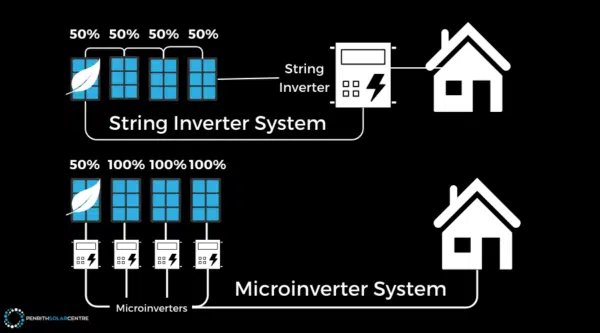
A common misconception when building a new home is to wait until the roof is complete before you talk to a solar installer. It’s logical. Solar goes on the roof, the roof goes on the house, and if the house and the roof aren’t built, why would you start shopping for solar?
If you are building a home and plan on installing solar on the roof, there are some things you might want to consider doing before you dive into building your home. A solar system is a complex piece of technology, and you can maximise its efficiency for your home (saving you money) with a little insight from an experienced installer.
At Penrith Solar Centre, we know how to milk every last kilowatt out of those solar panels on the roof. We’ve been installing solar for years, and as a company full of electricians, we pride ourselves on knowing how something as simple as how a perfectly installed cable run can save you pennies a day that add up to dollars per week which leads to savings every year.
Now imagine that level of detail and customisation with every component in your system.
In this article, you will learn:
- The Unfortunate Reality of Building Homes in the Sydney Metro Region in 2024
- Things About Solar to Consider When Building a New Home
- How to Talk to Your Builder About Solar
- How to Choose a Solar Installer
By the end of this article, you’ll understand what you and your builder should discuss before and while your build is happening and how to shop for the right solar installer and retailer. Off we go!
The Unfortunate Reality of Building Homes in the Sydney Metro Region in 2024
The cost of building a home has significantly increased since the pandemic happened. In Sydney, we’re seeing ethical and honest builders going broke on a weekly basis and being replaced with cheaper alternatives. Reputable giants in the industry who have been around for 30 years are going into liquidation, which is tragic.
Inflation is affecting everyone. The ropes are tightening on the building industry; the increasing cost of goods and the length of time it takes from signing the contract to getting the keys is increasing drastically.
Whether it’s 6 months or as long as 3 years, the cost of materials is increasing so rapidly that the materials often cost more by the time you begin construction than they did when you signed the contract. If you agreed to a $600,000 contract and the cost of building materials goes up by 15%, the actual cost of the build needs to increase by 8 – 10% for the builder to be able to cover those costs. Customers won’t pay that, why would they? Builders have to cover that.
What does that mean for you? If the building company tightens their ropes to break even, they’re going to take every shortcut they possibly can. While that’s the opposite of our ethics, we are compassionate to their situation.
In October 2023, the BASIX requirements tightened. There are so many things you would have to do to compensate for a lack of solar on the roof in order to get a BASIX certificate, that it’s more or less a done deal to put solar panels on a new home. The installation of a solar system, any solar system, generates a high enough score that you won’t have to worry about meeting other requirements like double-glazed windows.

If you were a builder struggling to break even, would you:
- recommend a quality solar system guaranteed to save your client money long-term, or
- would you pay a fraction of the cost for a system that’s not only cheap, but not big enough to do much more than run your air conditioner for 45 minutes or so?
That’s a trick question. We both know what they will do.
And honestly, we doubt they are trying to rip you off. They just don’t understand the difference between solar panels, inverters, and the decisions that are made around installing them.
Solar companies known for high-quality installations typically don’t offer cheap options. Penrith Solar Centre, for instance, employs skilled in-house electricians and Enphase installers. This expertise adds to the cost. Builders often overlook these companies due to their higher prices. Unfortunately, this leads to a cycle where solar installations in new builds are of an extremely poor quality.
Recently, our Director, Jake Warner, saw a prime example near his home: The homeowner invested in a stunning $1.2 million home by a renowned builder. This builder is known for their exquisite craftsmanship. Yet, despite the home’s grandeur, it was finished with a subpar $4,000 solar system.
The solar system was not only cheap but also poorly installed. It was haphazardly placed on the roof, disregarding aesthetics and efficiency. With a black roof, there was a perfect opportunity for a sleek east-west split system with matching black panels and racking. The installation lacked attention to detail. The panels had silver racking and black frames but mismatched white back sheets. Additionally, the visible nuts and bolts were silver, and a conduit ran clumsily down the side of the house.
The overall impression was that no one cared about the quality of the installation. It’s a stark reminder of the importance of choosing reputable solar companies for new builds to avoid such disappointing outcomes.
As a consumer building a new home, it’s better to handle solar privately or install it after receiving the keys. You absolutely can do that as long as it’s in your plan for BASIX.
People think that solar doesn’t work because these cheap, often malfunctioning string solar systems are slapped up on these multimillion-dollar homes to tick off a checklist. It’s about as useful as a chocolate kettle.
There is no regard for your energy needs or goals.
If you’re interested in learning more about BASIX, you might want to check out the following article titled, What Are the BASIX Requirements for NSW, Australia?
Things About Solar to Consider When Building a New Home
In the solar industry, it’s all about saving money. Every decision you make around your solar system should be maximising your savings. A good solar installer will understand how small changes to your build can save you money on electricity in the long run.
Shading:
The secret is out that solar panels don’t work in the shade, whether it’s from a tree or a cloud, the sun can’t power those panels without line of sight. If you love big, beautiful trees on your property (who doesn’t?), the shade from them will affect your solar production. The same goes for nearby buildings or the shade from something like a telephone pole.
We’re on top of all things shading-related here at Penrith Solar Centre. Mostly because we install Enphase microinverter solar systems. If your roof will get a lot of shade during any time of day due to what we mentioned, you’ll want to either invest in a microinverter solar system or reconcile yourself to cut down some trees. Which is a horrible thing to do, I think we can all agree.
Microinverter solar systems (which is the type of system we install) are fantastic at mitigating the effects of shading on your roof. When shade (whether it’s caused by a tree, a cloud, or a leaf that landed on the panel) reduces the efficiency of your solar panels, microinverters make sure each panel outputs as much power as possible without affecting the entire array. They monitor power production at the panel level, making sure each panel is performing at its peak.

A string solar system is vulnerable to shading. If one panel on the string is shaded (whether it’s caused by a tree, a cloud, or a leaf that landed on the panel), the other panels in the string drop in efficiency to match the underperforming panel. If 50% of a panel is obscured by shade, the other panels will output at 50% as well. They work like Christmas lights: one goes out and the efficiency of the other panels drop to match it and reduce the output of the string.
There are other things on your roof can cause shading too. Where is your chimney going and will it shade a solar panel or two over the course of an afternoon? A TV antenna, or one of those spinning vent thingies? They have shadows.
If you’re interested in learning more about microinverter solar systems and why they’re a phenomenal solution for shading concerns, you might want to check out the following article titled, Myths & Misconceptions About Solar Microinverters.
Roof Design:
There is a horrible rumour in Australia that you can only install solar panels on the northern-facing roof of your home. But that might not be the best placement on your roof for your unique needs and goals.
There is an incredibly strong argument to be made for eastern and western-facing solar panel placement. It really depends on when you and your family are home and how, when you use electricity, and how much money you would like to save.
We have written extensively on the topic. If you’re interested in learning a little more about how the compass direction of your roof and the way the solar panels face impacts your solar power production, you might want to read the following articles titled, Which Way Should Solar Panels Face in Australia? and Can You Install Solar Panels on a South-facing Roof in Australia?
Electrical Considerations:
There’s an issue of wiring/cabling. Your builder will have electricians and plumbers run wires and pipes through the walls before they put up the gyprock. If you consult with a solar installer, we can work with your electrician and between the two of us, figure out the best way to install the wiring for solar. It saves so much time when we arrive to install your solar.
There’s also the issue of what type of meter your builder installed. When you install solar in Australia, every home must upgrade its electrical meter to a smart meter.
A smart meter is a digital version of the old meters they used to install to report your electricity usage back to your retailer. There was an inefficient system of estimates on your bill based on the previous quarter. The smart meter measures energy usage; how often and how much.
It costs money to replace an old meter with a smart meter, so make sure you install a smart meter that won’t need upgrading later.
If you’re interested in learning more about smart meters, you might want to check out the following article titled, Smart Meters and Solar.
How to Talk to Your Builder About Solar
It starts with a simple chat with your builder, just a conversation. If they aren’t fully transparent with you about the equipment they’re installing, how the upfront cost stacks up against a payment period, and why they made the choices they made with the installation, find someone who will be fully transparent with you. These are the things you need to listen for if you’d like to save money with solar.
We’ve heard horror stories about builders marking up string inverter solar systems to the price point of a microinverter system. We’ve also seen solar systems so poorly installed that we’ve needed to replace them for customers.
There was also a customer whose builder was advocating for solar, but when the customer rejected the string inverter system she was offered by the builder, he refused to allow any solar installers on the property until the home was finished.
Now, there are heaps of honest, ethical builders out there. Hopefully, they point you in the direction of a solar installer who can answer your questions about energy efficiency. There are so many variables in each solar installation that an expert needs to assess your needs and goals. It starts with the design of the system.
If you’re serious about maximising your savings, you’ll want the design of that roof to inform the design of that solar system. For example, if you want a lot of skylights for natural lighting inside, you’ll need to discuss where the solar will go early in the building process.
In an ideal world, you, your builder, and your solar installer would all be chatting about design issues and how to save you money. Unfortunately, that level of cooperation doesn’t happen too often. That type of transparency gives you the control to prioritise and act on solar-related issues in your build, which will save you money long-term.
If you’re interested in reading up a bit on how to start making decisions around your solar system, you might want to check out the following article titled, How Much Solar Do You Need?
How to Choose a Solar Installer
There’s an incredibly lovely article on the Australian government’s website for the Department of Climate Change, Energy, the Environment and Water. It’s called Choose Your Solar Retailer and Installer, and it’s so good, we’re going to touch on some of the points they list, with a little additional insight.
There are tons of solar installers to choose from. Who you choose as an installer will matter more than any other choice you make around your solar system. An installer who knows what they’re doing will work with you to maximise your system’s efficiency.
You’ll need to decide early on what type of system you want to install; a microinverter system or a string inverter system (which includes any other additional tech like hybrid inverters or DC optimisers). Microinverter solar systems are very different from string inverter systems. Not everyone has the training to install them (or the interest). While the choice of who installs your system is the most important component of your solar installation, you won’t know who to talk to until you decide between microinverters or string inverters.
If you’re interested in learning a bit more about the pros and cons of string inverters versus microinverters, you might want to check out the following article titled, Microinverters vs. String Inverters: An Honest Comparison.
Your installer must be accredited by the Clean Energy Council to install rooftop solar. If your solar installer is not accredited by the CEC, you won’t receive the federal government solar rebate (also known as the Small-scale Renewable Energy Scheme (SRES) which awards Small-scale Technology Certificates (STCs) based on the size of your solar system).
If you’re interested in learning a bit more about the solar rebate, you might want to check out the following article titled, How Does the Solar Rebate Work?
We have a few tips for you as you make your choice of solar installer (even if it isn’t us):
- Get quotes for different types of solar systems so you have an idea of pricing.
- Investigate those companies. Have they been around for a long time? Do they offer after-sales support? Do they fulfil warranty claims or does the subcontractor? Read reviews and be suspicious of cold calls (but that’s just good life advice that applies to every industry).
- Request site visits from anyone who quotes you a system. Make sure you ask how long the quote is valid.
- Get an itemised breakdown of your investment. It’s not just the budget (cost of parts and labour), it should also include figures for your payback period and return on investment for the lifetime of the system.
- Solar systems almost all have a monitoring system of some sort. Considering the price point of a solar system, the monitoring app should be free, but not all of them are. If you need help setting it up and learning how to use it, talk to your installer. If they can’t help you, find an installer who can.
Swimming with Sparks: Designing Solar for a New Build
Now you know a bit about building a home with the intention to one day install solar upon it. It’s really just about having conversations with your builder as you shop for a solar installer, and then, once you find them, getting them to have conversations with your builder too. Transparency, in our experience, ends up saving time and money.
At Penrith Solar Centre, we understand that there are lots of considerations for installing a new solar system. And every consideration will be different for each customer. Your goals and needs are different from your neighbours. We understand the complexities of working with builders and we’re here to help you navigate that relationship as you install solar on your new home.

If you’re interested in learning more about how to start your solar journey, you might want to check out the following article titled, How to Shop for Your Solar System.










